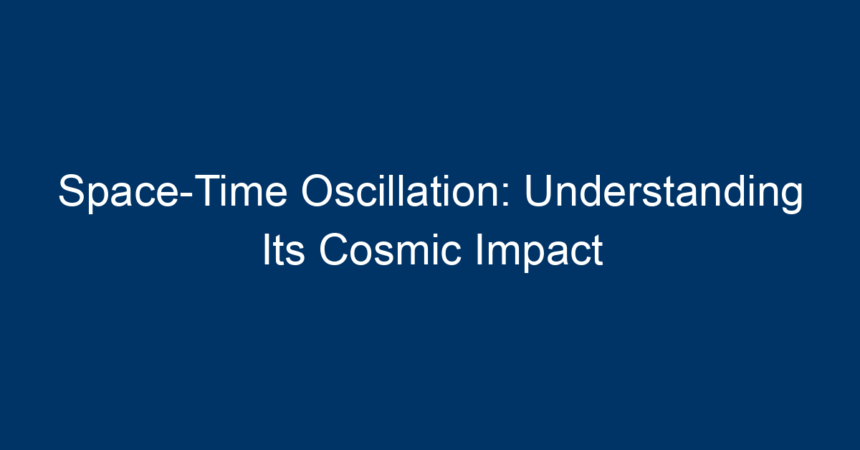Introduction
In the vast universe, where the laws of physics intertwine in intricate ways, the phenomenon of space-time oscillation stands out as a captivating subject for both scientists and enthusiasts alike. This oscillation is not merely an abstract concept; it has profound implications for our understanding of the universe, influencing everything from gravitational waves to the expansion of galaxies. In this article, we will explore the intricacies of space-time oscillation, its significance in cosmology, and how it impacts our perception of reality.
What is Space-Time?
Before delving into space-time oscillation, it’s essential to grasp the concept of space-time itself. Proposed by Albert Einstein in his theory of relativity, space-time combines the three dimensions of space with the dimension of time into a singular continuum. This revolutionary idea reshaped our understanding of gravity, motion, and the universe, illustrating that time and space are interconnected.
The Basics of Oscillation
Oscillation refers to any periodic movement or fluctuation in a defined system. It can be observed in various physical phenomena, such as a pendulum swinging back and forth or sound waves propagating through air. In the context of space-time, oscillation suggests variations in the fabric of the universe itself, which can occur due to various factors, including cosmic events, gravitational waves, and even theoretical constructs like dark energy.
Space-Time Oscillation Explained
Space-time oscillation can be understood as periodic alterations in the metrics of space and time. These fluctuations can emerge from dynamic cosmic events, such as the collision of black holes, the explosion of supernovae, or the subtle dance of celestial bodies in orbit. While these events may seem localized, the repercussions of these oscillations can ripple throughout the universe, affecting distant galaxies and cosmic structures.
The Role of Gravitational Waves
One of the most significant phenomena associated with space-time oscillation is gravitational waves. First predicted by Einstein’s general theory of relativity, these ripples in space-time carry energy generated by massive movements, such as merging black holes or neutron stars. Detected for the first time by the LIGO observatory in 2015, gravitational waves serve as a form of measurement for space-time oscillation.
When these waves pass through an area, they cause fluctuations in the distance between objects, stretching and squeezing space-time. This discovery has opened a new window into observing and understanding cosmic events, confirming theoretical predictions and enhancing our comprehension of the universe.
The Cosmic Impact of Space-Time Oscillation
The implications of space-time oscillation are profound, affecting not just our scientific understanding but also our philosophical perspectives on the nature of reality. Here are several key areas where space-time oscillation has a cosmic impact:
1. Cosmic Structure Formation
Space-time oscillations play a crucial role in the formation and evolution of cosmic structures. As galaxies and larger structures form through gravitational attraction, the oscillations in space-time can influence their development. For instance, regions of space-time that experience different oscillation rates can lead to variations in the density of cosmic matter, driving the clustering of galaxies.
2. Understanding Dark Energy
The mystery of dark energy—a force driving the accelerated expansion of the universe—has been a point of contention in cosmology. Some theories suggest that space-time oscillation may interact with dark energy, affecting how this enigmatic force influences the universe’s expansion. By studying space-time oscillations, researchers hope to gain insights into dark energy’s nature, potentially unraveling one of the universe’s greatest mysteries.
3. Black Holes and Singularities
Space-time oscillations are particularly pronounced around black holes, where gravitational forces are intense. The oscillation of space-time can lead to phenomena such as gravitational lensing, where light from distant stars is bent around a black hole, allowing astronomers to see objects that would otherwise be obscured. Understanding these oscillations can enhance our knowledge of singularities—points where gravitational forces cause matter to become infinitely dense.
4. Time Dilation and Relativity
Einstein’s theory of relativity introduced the concept of time dilation, where time passes differently based on an observer’s relative speed or gravitational field strength. As space-time undergoes oscillations, these effects become intricately woven into the fabric of reality. For example, satellites in orbit experience time differently than those on Earth due to gravitational differences, showcasing how space-time oscillation shapes our temporal experiences.
The Future of Space-Time Oscillation Research
As technology advances, the study of space-time oscillation is poised for significant breakthroughs. New observatories and tools enable scientists to detect and analyze gravitational waves with unprecedented precision. These advancements will provide deeper insights into cosmic events and refine our theories regarding the structure and dynamics of the universe.
Emerging Technologies
- Advanced Detectors: Future gravitational wave detectors will evolve beyond current models, allowing for even finer measurements that could reveal more about space-time oscillations.
- Quantum Computing: Utilizing quantum computing may revolutionize our ability to simulate complex cosmic environments, enhancing our predictive models of space-time behavior.
Conclusion: Embracing the Cosmic Dance
Space-time oscillation is a profound concept that underlies much of our understanding of the universe. Its implications stretch far beyond theoretical physics, touching on fundamental questions about reality, existence, and our place in the cosmos. As we continue to uncover the mysteries of space-time oscillation, we are not only expanding our scientific horizons but also enriching our philosophical understanding of life and the universe.
Actionable Insights
- Stay Informed: Follow the latest research and discoveries in gravitational wave astronomy to deepen your understanding of space-time oscillation.
- Engage: Participate in discussions about the implications of this phenomenon in scientific communities and online forums.
- Explore Literature: Delve into books and papers that explore the intersection of cosmology, physics, and philosophy to enhance your appreciation of the cosmic dance of space-time.
By striving to understand space-time oscillation, we not only illuminate the grand complexities of the universe but also embrace the wonders that lie within our very existence.




